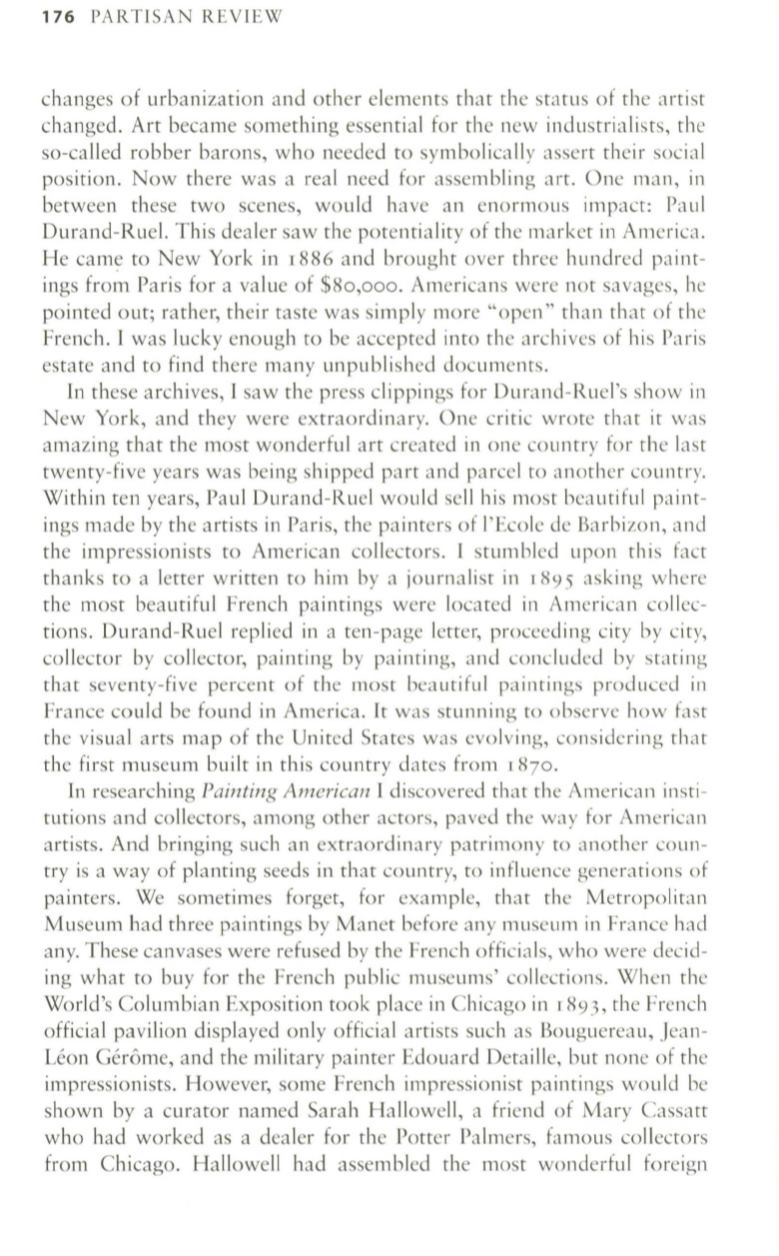
176
PARTISAN REVIEW
changes of urbanization and other elements that the status of the artist
changed. Art became something essential for the new industrialists, the
so-called robber barons, who needed to symbolically assert their social
position. Now there was a real need for assembling art. One man, in
between these two scenes, would have an enormous impact: Paul
Durand-Rue!. This dealer saw the potentiality of the market in America.
He
cam~
to New York in
J
886
and brought over three hundred paint–
ings from Paris for a value of
$80,000.
Americans were not savages, he
pointed out; rather, their taste was simply
more
"open" than that of the
French. I was lucky enough to be accepted into the archives of his Paris
estate and to find there many unpublished documents.
In
these archives, I saw the press clippings for Durand-Ruel's show in
New York, and they were extraordinary. One critic
wrote
that it was
amazing that the most wonderful art created in one country for the last
twenty-five years was being shipped part and parcel to another country.
Within ten years, Paul Durand-Ruel would sell his most beautiful paint–
ings made by the artists in Paris, the painters of l'Ecole de Barbizon, and
the impressionists to American collectors. I stumbled upon this fact
thanks to a letter written to him by a journalist in
1895
asking where
the most beautiful French paintings were located in American collec–
tions. Durand-Ruel replied in a ten-page letter, proceeding city by city,
collector by collector, painting by painting, and concluded by stating
that seventy-five percent of the most beautiful paintings produced in
France could be found in America.
It
was stunning to observe how fast
the visual arts map of the United States was evolving, considering that
the first museum built in this country dates from
1870.
In
researching
Painting American
I discovered that the American insti–
tutions and collectors, among other actors, paved the way for American
artists. And bringing such an extraordinary patrimony to another coun–
try is a way of planting seeds in that country, to influence generations of
painters. We sometimes forget, for example, that the Metropolitan
Museum had three paintings by Manet before any museum in France had
any. These canvases were refused by the French officials, who were decid–
ing what to buy for the French public museums' collections. When the
World's Columbian Exposition took place in Chicago in
1893,
the French
official pavilion displayed only official artists such as Bouguereau, Jean–
Leon Gerome, and the military painter Edouard Detaille, but none of the
impressionists. However, some French impressionist paintings would be
shown by a curator named Sarah Hallowell, a friend of Mary Cassatt
who had worked as a dealer for the Potter Palmers, famous collectors
from Chicago. Hallowell had assembled the most wonderful foreign


